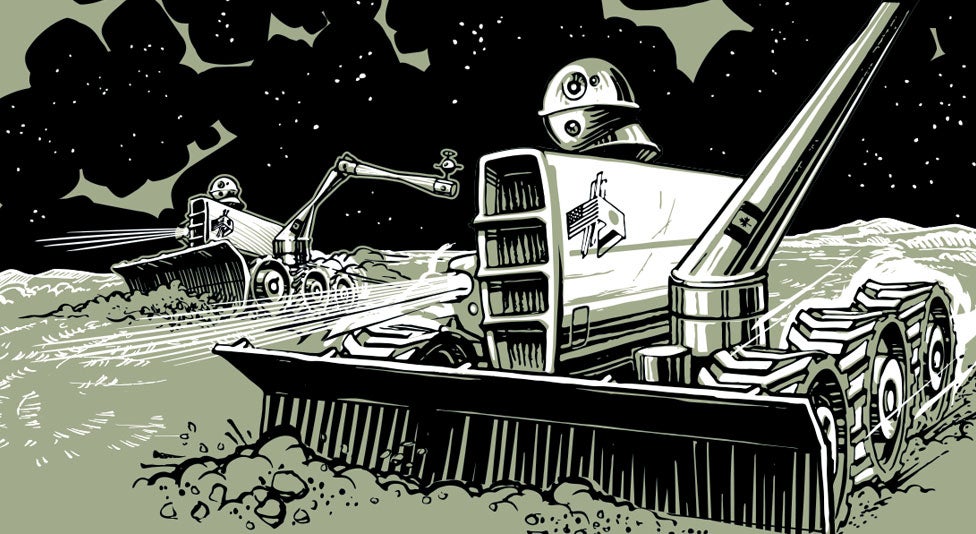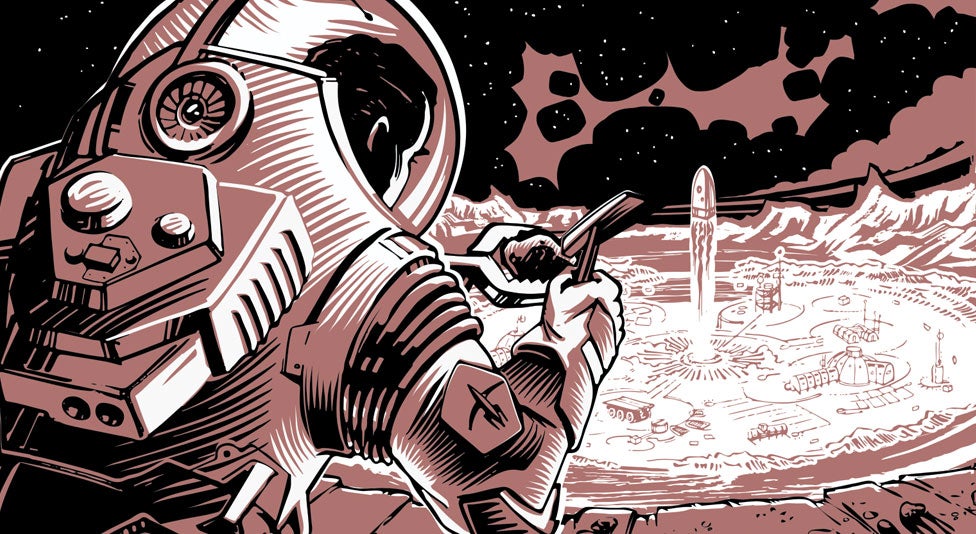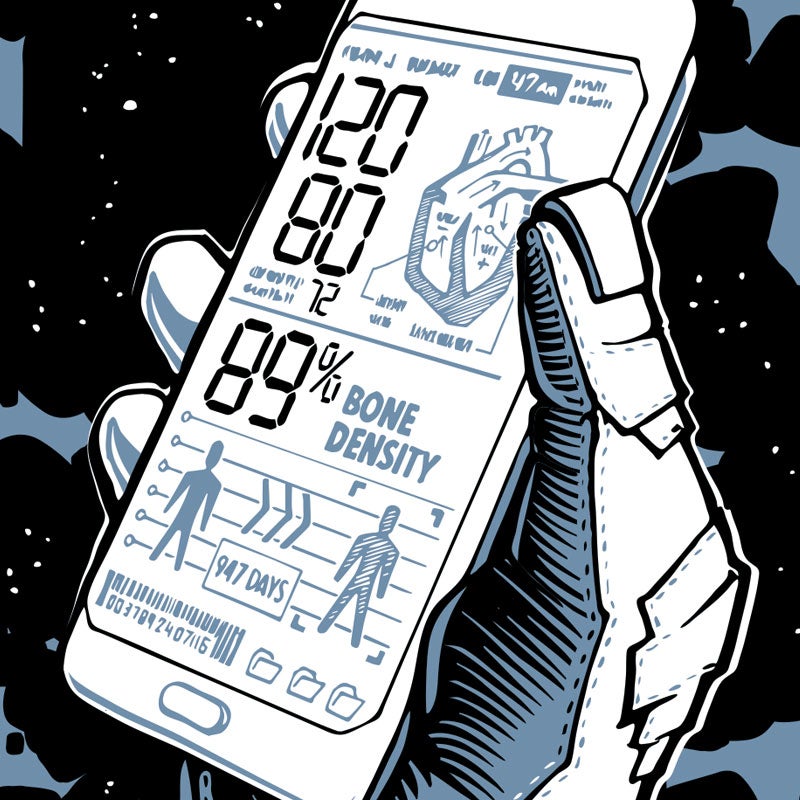
Where to Next?
Summer 2016 | By Pat Duggins ’84 and Laura J. Cole
The final countdown of the space shuttle program began on July 8, 2011, when Atlantis blasted off from NASA’s Kennedy Space Center (KSC). It came to an end 13 days later when the spacecraft glided down KSC’s 15,000-foot runway and rolled to a stop. For some, this final flight signaled the end of U.S. space exploration. But nothing could be further from the truth.
Since then, the Curiosity rover successfully landed on Mars. Voyager 1 became the first man-made spacecraft to reach interstellar space. New Horizons flew past Pluto, sending back the first images of the dwarf planet. Commercial space flight companies Blue Origins and SpaceX successfully launched and landed rockets back on Earth, proving the viability of reusable rockets. And Scott Kelly broke the record for the longest consecutive time spent in space by a U.S. astronaut — spending 340 days aboard the International Space Station — providing valuable information about the impact of extended space travel on the human body.
It’s safe to say that space exploration is a more robust endeavor than ever before with both the private and public sectors working to find new, cheaper ways to explore our solar system and beyond. With all we’re learning about the final frontier, scientists at UCF and elsewhere are looking ahead with anticipation. Their interest raises questions of who funds these exploratory endeavors, how we reach distant planets, who leads the charge and why cosmic curiosity is as worthwhile now as it was when NASA began more than 50 years ago.
Building Partnerships

Since the shuttering of the shuttle program, there has been media discussion about the privatization of space. While it’s true that private companies will have a larger role in space exploration, NASA will continue to play an integral role. In fact, commercial companies and NASA have always worked together.
“There’s a little bit of a misconception about that,” says Joshua Colwell, professor of planetary science and assistant director of the Florida Space Institute (FSI). “Private industry has always been involved in everything NASA does. Huge parts of the space shuttle were built by private companies.”
Officials at NASA agree. One example of this is the Apollo program. During the race to the moon in the ’60s, commercial companies played a meaningful role in building the hardware that put Neil Armstrong on the lunar surface. Growing up, Dale Thomas, former associate director of NASA’s Marshall Space Flight Center, remembers watching his father, an employee for General Electric, build the Apollo launch sequencer.
That experience piqued his interest in the space business, especially in terms of how public companies like NASA and private industries could better work together. He began exploring this more in the early 2000s with the Space Launch Initiative, a joint research and technology project between NASA and the Department of Defense that began with reusable vehicle study contracts, much like the rockets developed by SpaceX and Blue Origin.
Throughout the process, Thomas and his team at the Marshall Center provided guidance and discussed possible solutions for the problems SpaceX was encountering.
Of the partnerships, he says, “We never saw it as an either/or proposition. We saw it as good all along that private industry was trying to develop cheaper ways to get to orbit.”
According to Colwell, the major change going forward is “we’ll let SpaceX design a rocket, and NASA will purchase the services to take astronauts or materials to a space station instead of launching it on a rocket designed and owned by NASA.”
“We’ve created capabilities for commercial operators to do a lot of what needs to be done in low Earth orbit. I see that market being really the domain of commercial services while the government continues to push the frontier out.”Ramon Lugo, director of the Florida Space Institute
Ultimately, these types of partnerships reduce the overall costs associated with building, flying and maintaining space vehicles. But NASA will still shoulder the expense of reaching new heights in space.
Think of NASA’s partnership with commercial companies as being similar to the development of the transcontinental railroad in the 1800s, which provided a faster, cheaper way to travel from New York to California. Government agencies funded the initial infrastructure, clearing paths and laying track. And once the infrastructure was established, private industry was brought in to run, schedule and maintain the trains.
The same principle could apply in the future to low Earth orbit.
“We’ve created capabilities for commercial operators to do a lot of what needs to be done in low Earth orbit,” says Ramon Lugo, director of FSI, which is based at UCF. Lugo, a former director of NASA’s Glenn Research Center, continues, “I see that market being really the domain of commercial services while the government continues to push the frontier out.”
Lugo, Colwell and Thomas all agree this would be an ideal relationship. The government should pay for the resources and new technology to learn more about our solar system while private industry should find new ways to improve on how that’s being done.
This partnership extends beyond the U.S. as well. In order to reach new depths of the solar system, NASA and private industries will need to work with Europeans, Russians and the Japanese, much as we have on the ISS. These collaborations have already begun with projects like NASA’s Orion spacecraft, which aims to carry astronauts farther into space than ever before and is scheduled to launch in 2017. To achieve this, NASA partnered with the European Space Agency, which provided the service module — the part of the spacecraft that carries fuel.
“In the long term, we’ll be working with all of the international partners, including the Chinese and Russians,” says Daniel Dumbacher, former deputy associate administrator for Exploration Systems Development at NASA Headquarters in Washington, D.C. “It’s going to evolve into a partnership because no one country can do this by themselves.”

Reducing Costs
If you think driving across the country takes a long time and gas prices are expensive, try flying to Mars. At its closest, it’s still 34.8 million miles from Earth and can take anywhere from about 150 to 330 days to reach. And even with the most efficient flight plan, it’s still an energy-intensive venture that requires several tons of propellant.
As for the actual cost, industry sources estimate between $200 billion to $400 billion for NASA to put humans in contact with Mars’ red, dusty soil — far exceeding their $8 billion annual budget for human exploration. Even the modestly priced Mars One, the Netherlands-based nonprofit that wants to send people on a one-way trip to colonize the red planet, estimates $6 billion to send the first four people. (Though experts are highly skeptical of that estimate.)
And that’s just getting to one of the closest planets in our solar system. To make such a trip possible, scientists are looking at ways to reduce the cost, including developing reusable rockets and identifying potential stopovers to reduce the amount of fuel used.
“A lot of the future of space exploration is reusability, and SpaceX is looking at that,” says Colwell. “The space shuttle was reusable, but because it was such a large and complex system … it didn’t really bring the cost down the way they had originally imagined it would. SpaceX, on the other hand, is now regularly recovering their first-stage boosters, and they’ve announced plans to send a capsule to land on Mars in 2018 at a much lower cost than what it would have been with the old launch architectures.”
Another way to reduce costs is by finding creative solutions to reduce fuel use and minimize hazards. That’s where Pegasus Professor Humberto Campins, an asteroid expert, may play a big role. He and Professor Daniel Britt were selected to review a concept that will send a robotic spacecraft to a near-Earth asteroid, grab a multiton boulder from its surface, and relocate the chunk of space rock into orbit around the moon. The new technologies needed for this mission will allow scientists to study the asteroid closer to Earth and also help pave the way for a manned mission to Mars in the next 15 to 20 years.
Instead of having astronauts fly directly to the surface of the red planet, which would involve a hazardous landing, NASA is thinking about a stopover on one of Mars’ two moons. Each of these orbiting satellites has less gravity to crash a spacecraft and no atmosphere to burn it up.
Here’s how that might work. Instead of having astronauts fly directly to the surface of the red planet, which would involve a hazardous landing, NASA is thinking about a stopover on one of Mars’ two moons. Each of these orbiting satellites has less gravity to crash a spacecraft and no atmosphere to burn it up. Once on Phobos, the larger of Mars’ two moons, astronauts could scout a safe landing site on Mars and make the touchdown when they’re better prepared, also allowing them to conserve fuel.
“Phobos appears to have a similar composition as many types of carbonaceous asteroids, so learning how to use [an asteroid’s resources] is a first step before going to Phobos,” says Philip Metzger, a planetary scientist at FSI who specializes in technologies for mining asteroids, the Earth’s moon and Mars.
Within the next 50 years, scientists predict NASA will have well-established bases on both the moon and Mars. These bases would allow astronauts to use natural resources for much of what they need to live and work as well as pave the way for exploration of more distant destinations, like Jupiter’s moons.

Using Robots
NASA is hoping to send astronauts to Mars in the 2030s, but there’s still a long way to go before people will be permanently living there. One popular strategy of prepping other planets for humans involves using robots.
Metzger, who worked at NASA for more than 29 years, calls this bootstrapping the solar system. In 2013, he wrote a paper for the Journal of Aerospace Engineering about doing just that, garnering the immediate attention of the White House.
“Appropriately designed robots will not have the problems traveling the vast distances of the solar system that humans have, and they can set up the infrastructure that will enable us to follow,” wrote Metzger. “Within the first several decades, a vital industry could be established on the moon and in the asteroid belt using technologies that are, for the most part, only modestly advanced beyond today’s state of the art. After that, human outposts, laboratories and observatories can spring up everywhere between the Kuiper Belt and Mercury.”
On Mars, Metzger envisions robots using soil and 3-D printers to create necessities, such as landing pads for safer arrivals and radiation shields around habitats to minimize astronauts’ exposure to the harsh environment. Robots would also be used to construct buildings.
“Appropriately designed robots will not have the problems traveling the vast distances of the solar system that humans have, and they can set up the infrastructure that will enable us to follow.”Philip Metzger, planetary scientist at FSI
Metzger is currently working to make that last part possible. He will be the lead contact for UCF on a recently awarded project to develop the 3-D printing technology to create buildings on Mars, using the natural clays found on the red planet. By creating simulated Martian clay based on information they know from Mars rovers, Metzger and his team, in collaboration with Deep Space Industries, will show how using robots to construct buildings from available resources could be possible.
And while the game plan is to have robots precede humans to Mars, robots will also be vital to every part of the mission once astronauts do arrive, acting as guides, scouts and assistants. The word for this is co-robotics.
“Robots will be everywhere,” Metzger says. “Let’s say you’re driving in a rover. You could send a drone ahead of you to scout where you’re going. The drone takes pictures and sends them back. The astronauts, with help from Mission Control, make decisions about where to go next, so they don’t drive off a cliff or so they can get to a more interesting geological site to find better samples.”
Combining robotic and astronaut missions could potentially put to rest the age-old argument of whether to use manned or unmanned spacecraft to explore the cosmos.

Learning More
Whenever arguments begin over funding the U.S. space program, someone invariably asks, “Why don’t we spend that money here on Earth?” Studies, however, show a $7 to $40 return for every dollar invested in space, with much of the technology and inventions made for space exploration having applications on Earth.
Assuming the space program’s goals become more ambitious in the future, so will the problems that will need to be solved. Exploring these problems, however, produces several benefits. Take for example the issues of vision, bone and muscle loss found in astronauts after returning from space.

Dumbacher is familiar with this type of research. He previously ran NASA’s Payload Operations Center, where it was his job to supervise science research aboard the ISS. This included studies on how weightlessness impacts the human body.
“Macular degeneration and muscle and bone loss seen after long space flights are very analogous to the natural aging process here on Earth,” Dumbacher says. “Through longer time spent in space, we can learn more about the human body and how it works.”
Astronaut Scott Kelly’s 340-day flight aboard the ISS is a case study on the impact of long-duration space flight on the human body. After landing in Kazakhstan in March, Kelly reported having burning skin, rashes and flu-like symptoms. Even three months after returning to Earth, he reported having sore feet, stiff legs and fatigue.
“But that’s why we do this,” he said during his first major address to NASA employees in May. “We need to learn these things if we’re going to go to Mars.”
While he was in space, his identical twin brother, Mark, a retired astronaut, took part in medical experiments here on Earth, so NASA could more accurately compare the effects of different environments on the brothers. Scientists continue to monitor the twins to learn more, in hopes of addressing issues like bone and muscle loss before sending humans on lengthy journeys into the void. And those solutions can translate to medical advances on Earth.
“So much progress is being made in space, and students are in a position now where they can really create the future.”Joshua Colwell, professor of planetary science
In addition to a better understanding of health issues, Lugo points to the potential for more efficient communication satellites, which could result in better satellite-related services here on Earth. New technology is needed for longer space missions, and one potential solution is an electrical ion engine that uses less fuel. That idea could lower the costs of orbiting satellites, and, in turn, the price of consumer services like cable and internet. Lugo contends that refuelable engines will make satellites last longer.
“A lot of times, a satellite is taken out of service, not because the satellite is no longer viable from an operations standpoint, but because we run out of gas,” he says. “And instead of lasting 10 years, [a satellite with refuelable engines] might last 30 or 40 years.” Lugo says those cost savings could be passed along to consumers.
Passing the Torch
For Colwell, the biggest benefit of space exploration — now and in the future — is empowering the next generation of space explorers to look to the stars and see endless possibilities.
“I think broader access to space is great for us as a university because it gives us more opportunities to get students involved in space projects. That’s one of the things we really strive for,” he says. “So much progress is being made in space, and students are in a position now where they can really create the future.”

ILLUSTRATIONS BY BRIAN BOESCH
Pat Duggins ’84 is news director for Alabama Public Radio and an international award-winning journalist. He has covered 103 space shuttle missions and written two books: Final Countdown: NASA and the End of the Space Shuttle Program and Trailblazing Mars: NASA’s Next Giant Leap.